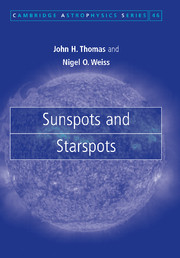Book contents
- Frontmatter
- Contents
- Preface
- 1 The Sun among the stars
- 2 Sunspots and starspots: a historical introduction
- 3 Overall structure of a sunspot
- 4 Fine structure of the umbra
- 5 Fine structure of the penumbra
- 6 Oscillations in sunspots
- 7 Sunspots and active regions
- 8 Magnetic activity in stars
- 9 Starspots
- 10 Solar and stellar activity cycles
- 11 Solar and stellar dynamos
- 12 Solar activity, space weather and climate change
- 13 The way ahead
- Appendix 1 Observing techniques for sunspots
- Appendix 2 Essentials of magnetohydrodynamic theory
- References
- Index
5 - Fine structure of the penumbra
Published online by Cambridge University Press: 28 October 2009
- Frontmatter
- Contents
- Preface
- 1 The Sun among the stars
- 2 Sunspots and starspots: a historical introduction
- 3 Overall structure of a sunspot
- 4 Fine structure of the umbra
- 5 Fine structure of the penumbra
- 6 Oscillations in sunspots
- 7 Sunspots and active regions
- 8 Magnetic activity in stars
- 9 Starspots
- 10 Solar and stellar activity cycles
- 11 Solar and stellar dynamos
- 12 Solar activity, space weather and climate change
- 13 The way ahead
- Appendix 1 Observing techniques for sunspots
- Appendix 2 Essentials of magnetohydrodynamic theory
- References
- Index
Summary
The most striking recent development in the study of sunspots has been the revelation of fine structure in intensity, magnetic fields and velocity patterns in the penumbra. Within the past 15 years new observations, notably those made first with the Swedish Vacuum Solar Telescope (SVST) on La Palma, then with the aid of adaptive optics on the Dunn Telescope at Sacramento Peak and the 1-m Swedish Solar Telescope (SST) and, most recently, with the Solar Optical Telescope on the Hinode spacecraft, have resolved delicate features with unprecedented clarity – and, in so doing, have posed major problems for theory to explain (Thomas and Weiss 2004). The filamentary penumbra appears clearly in Figures 1.2 and 3.1 and is shown here in greater detail in Figure 5.1.
In this chapter we discuss this fine-scale filamentary structure and the associated interlocking-comb configuration of the penumbral magnetic field. We begin with observations and describe first the two-dimensional intensity pattern in the penumbral photosphere. Then we go on to discuss the complex three-dimensional structure that is revealed by measuring two vector fields, the magnetic field B and the velocity u. This rich and intricate magnetic geometry results from interactions between convection and the inclined magnetic fields in the outer part of a sunspot. We next outline the current theoretical understanding of this form of magnetoconvection, and attempt to interpret the observed penumbral structure in the light of available theoretical models.
- Type
- Chapter
- Information
- Sunspots and Starspots , pp. 78 - 105Publisher: Cambridge University PressPrint publication year: 2008



